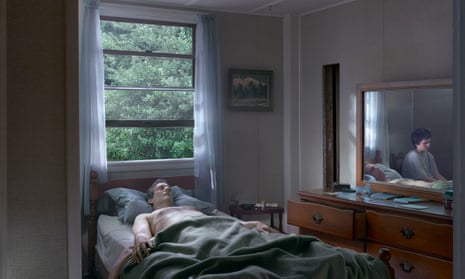In 2013, in retreat from “a difficult divorce”, Gregory Crewdson moved from Manhattan to a converted church in rural Massachusetts. “I had to relocate myself, physically and psychologically,” says the photographer. So he spent his time mountain trekking, long-distance swimming and, when the winter set in, cross-country skiing.
“I was out in the snow one day when I came upon a sign for a section of the Appalachian Trail called Cathedral of the Pines,” he adds. “It stopped me in my tracks, just the resonance of the name. I knew I had to use it.”
The resulting series is more sombre, foreboding and inward-looking than the meticulously staged cinematic photographs that made his name. It opens this week at the Photographers’ Gallery in London, the first time the institution has devoted all its gallery space to a single artist.
Cathedral of the Pines took two and a half years to shoot and, typically for Crewdson, required the kind of preparation that usually attends a Hollywood film: months of casting, location hunting and storyboarding, with an extensive crew to oversee lighting, props, wardrobe, makeup and even some special effects involving artificial smoke and mist.

“By my standards, it was relatively restrained,” he says, laughing and citing his 2008 series Beneath the Roses, which cost as much as a mid-budget movie and entailed four city streets being closed down for shots that required rain and snow-making machines.
Cathedral of the Pines was challenging in a different way. “These pictures are smaller in scale and, to a degree, they were more difficult because they were less spectacular. You have to create meaning and atmosphere in a more intimate way, which makes lighting, for instance, a lot more challenging.”
While still meticulously staged, these portraits seem more revealing and intimate in their evocation of individual souls who seem lost and adrift, despite the trappings of home and material success. The location is the small town of Becket, close to where he lives, and instead of actors and models, the subjects are people Crewdson knows, including his partner and creative collaborator, Juliane Hiam, and her daughter, Harper.
“There is a definite shift, but they are not directly autobiographical,” he says. “Some people have even noted that the work is a reflection of the mood in America at the moment, but that, too, was not intentional. Despite the preparation, a lot of what I do arrives out of another place deep in the unconscious and I am compelled to explore it. I didn’t set out to make this new iconography, but there it is all the same.”
Crewdson is a master of atmosphere. The characters who inhabit these stilled moments seem marooned in their own thoughts to the point of torpor, while the titles are functional to the point of deadpan: Woman Seated On Bed, The Basement, The Motel. The films of Alfred Hitchcock and David Lynch are often cited as touchstones for his earlier work, but this time the tone is reminiscent of stories by Raymond Carver, in which damaged individuals gravitate towards each other in drab motel rooms and darkly lit bars, but never really connect.
“That’s a great compliment,” says Crewdson, “Carver is one of my all-time favourite writers. Even the use of the word cathedral” – also the title of a Carver short story – “seems to me, in retrospect, to signal some unconscious connection.”
Crewdson was not always given to such sombre self-reflection, nor such grand artistic ambition. In 2005, Hewlett Packard launched a printer with an advert featuring a catchy post-punk song from 1979 called Let Me Take Your Photo. The group who recorded it were called the Speedies and boasted a young and hyperactive Crewdson on lead vocals. When I bring this up, he laughs.
“We were very much of the time,” he says. “A bunch of 16 and 17-year-olds hoping to be like our idols – Blondie, the Ramones and Television. There was a moment when we were a New York club phenomenon. We gigged with the Undertones and Gang of Four when they first toured in America. We even opened for the Jam at the Palladium. It was a wild moment, but it burned out pretty quickly.”

Crewdson turned to photography initially as a hobby, but his early work earned him a place at Yale. He cites Joel Sternfeld as an influence and tells me he that, as a student, he took an internship at his New York gallery just so that he could meet him. At Yale, he discovered the work of such conceptualists as Jeff Wall and Cindy Sherman, taking their staging and visual choreography as the starting point for his more cinematic constructions. The grand scale of his imagination has seen him embraced by the art market: he is represented by Gagosian in New York and White Cube in London.
He is now preparing to shoot his first feature film, Reflective Light. An adaptation of Carla Buckley’ s 2014 novel, The Deepest Secret, it’s about a teenage boy who is allergic to the sun. “He lives with his mother in a small town in the 1980s,” says Crewdson. “His life is very contained by day, centred around the darkroom he has set up in the basement of his house, but he also has some interesting nocturnal adventures. He falls in love. Things happen. That’s all I’m going to say at this stage.”
Will it echo the heightened style of his prints? “I see photography and film as all one thing,” he says. “But I am first and foremost a photographer. I’m not going to disappear completely into film-making. What interests me about this film is that it is primarily a visual story. It will be shot close to where I live and part of the process will be to give it the feel of my photographs. It will have my sensibility. You never truly get away from yourself.”

Comments (…)
Sign in or create your Guardian account to join the discussion